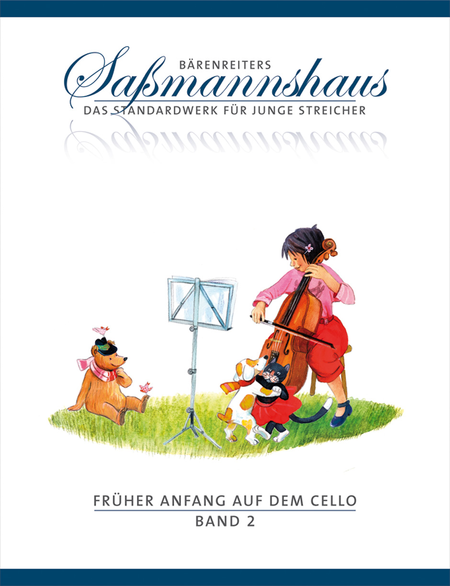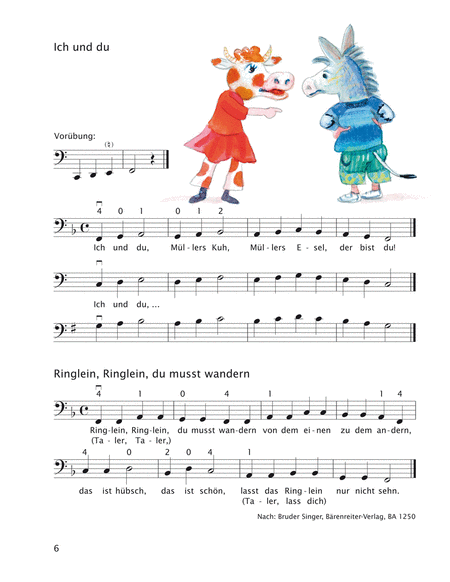Früher Anfang auf dem Cello, Band 2
Eine Violoncelloschule für Kinder
-
Ships in 1 to 2 weeks
Details
Description
SKU: BA.BA09692
Eine Violoncelloschule für Kinder. Composed by Egon Saßmannshaus and Kurt Sassmannshaus. Stapled. Barenreiter's Sassmannshaus. Seit 2008 komplett neu gestaltete Ausgabe, Replaces BA 6612. Violoncello-Schule (Cello Methods). Performance score. 64 pages. Baerenreiter Verlag #BA09692. Published by Baerenreiter Verlag (BA.BA09692).ISBN 9790006536559. 30 x 23 cm inches. Language: German. Illustrations: Charlotte Panowsky.
Please note our English language edition of this volume BA 8997.
Volume 2 in our series, with colour illustrations and easy-to-read fingering charts, is designed to expand the technique of the left and right hands and above all to introduce playing in other keys. In addition to nursery rhymes and folk songs, it contains classical recital pieces for two cellos to help learners improve their ability to read music and to prepare them for ensemble playing. The second finger is included, and students become acquainted with and receive training in dotted notes, 16th notes (semiquavers), first double stops, the extended finger pattern and alternating between normal and extended finger patterns. Depending on the pupil's level of achievement, Volume 3 of the cello tutor can be used in parallel. It is subdivided by finger patterns and key and provides easily locatable sections with additional practice material.
The authors
In 1976 Egon Sassmannshaus, one of the most experienced and renowned violin teachers in Germany, published his tutor “Früher Anfang auf dem Cello”. This standard work for young string players quickly became the most popular and best-selling tutor in the German-speaking countries for beginners on this instrument. His son-in-law Michael Corssen, the co-author of Volumes 3 and 4, is a baroque cellist and conductor who heads a music school in the German state of North Rhine-Westphalia. Egon Sassmannshaus's son, Kurt Sassmannshaus, functioned as co-editor of the English-language edition, “Early Start on the Cello” (BA 8996, BA 8997, BA 8998, BA 8999), adapting his father's successful tutor to meet the needs and requirements of English-speaking children.
The combined knowledge and experience of the Sassmannshaus/Corssen family make these four volumes the most thoroughly researched and thought-through cello tutor for beginners all over the world.
About Baerenreiter's Sassmannshaus
Children playfully learn reliable technique at the earliest age. For more than three decades the Sassmannshaus Tradition has been the household name for excellence in beginner methods in German-speaking countries. More than half a million students have successfully learned to play using this publication.
This tried and tested German method is now available in English! The best-selling method that gave generations of European musicians their foundation is now available in English, with content and songs newly adapted for today's English speaking children.
What makes this method so special?
- The child-friendly and age-appropriate text underlying the music enables children to perceive melodies as a whole and to understand their singable qualities.
- Songs and scales in different positions are easily explained and mastered within the first year. This is an important advantage over methods that confine children to the first position for many years.
- Note reading is emphasized from the first lesson - children are brought up to become proficient sight-readers and play in chamber music ensembles as early as possible.
- In contrast to other beginner methods, The Sassmannshaus Tradition progresses swiftly by introducing advanced techniques in rudimentary form, such as shifting and varied bow strokes.
- Ensemble playing is encouraged from the very beginning.
- The method is suitable for single instruction as well as for group and class lessons.
- The large print notes and text as well as many colorful illustrations are particularly child-friendly and very attractive to pre-school children and school children alike.
- The substantial volumes contain comprehensive material and carefully calibrated learning curves. They keep children curious and interested for many months and years.


 Share
Share